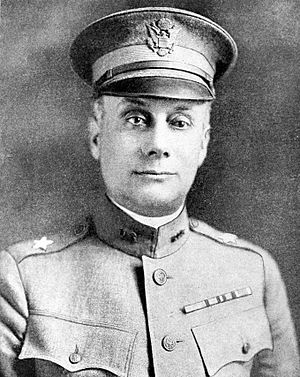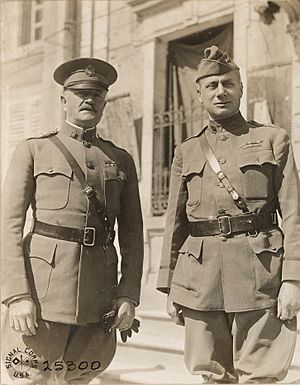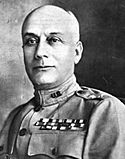William M. Wright facts for kids
Quick facts for kids
William M. Wright
|
|
|---|---|

William M. Wright as Brigadier General
|
|
| Born | September 24, 1863 Newark, New Jersey |
| Died | August 16, 1943 (aged 79) Walter Reed Army Medical Center |
| Place of burial | |
| Allegiance | United States of America |
| Service/ |
|
| Years of service | 1885–1923 |
| Rank | |
| Commands held | 19th Infantry Regiment Port of Embarkation, Hoboken, New Jersey 35th Division III Corps V Corps VII Corps 89th Division I Corps IX Corps Area Department of the Philippines |
| Battles/wars | Spanish–American War Philippine–American War Veracruz occupation Pancho Villa Expedition World War I |
| Awards | Distinguished Service Medal French Legion of Honor (Commander) French French Croix de Guerre with Palm Belgian Order of Leopold II (Grand Officer) Order of the Rising Sun (Japan) British Order of Saint Michael and Saint George (Commander) |
| Relations | Marjorie Jerauld (wife) (m. 1891) 3 children (including Jerauld Wright) Stevens Thomson Mason (grandfather) William Wright (grandfather) |
William Mason Wright (September 24, 1863 – August 16, 1943) was a lieutenant general in the United States Army. He is known for leading divisions and corps during World War I.
William Wright was the son of an Army officer. He gained attention when President Chester A. Arthur nominated him to be an officer. This happened even though Wright had failed exams at the United States Military Academy. His roommate there was John J. Pershing. Wright later joined the New Jersey National Guard. He then received his Army commission after a close vote in the United States Senate. Some senators felt that someone who failed at West Point should not get the same chance as those who passed.
Wright began his Army career in the western United States. He served as an aide to General John C. Bates during the Spanish–American War and the Philippine–American War. He also took part in the Veracruz occupation and the Pancho Villa Expedition.
During World War I, Wright commanded several divisions and corps. He fought in battles like the Battle of Saint-Mihiel and the final parts of the Meuse-Argonne Offensive. For his service, he received the Distinguished Service Medal and other awards.
After the war, Wright worked as an assistant to the Chief of Staff of the United States Army. He even acted as Chief of Staff sometimes. He finished his career leading the Department of the Philippines from 1922 to 1923.
In retirement, Wright lived in Washington, D.C. In 1942, a new law allowed general officers who were recommended for World War I promotions to be promoted on the retired list. Wright was one of two major generals promoted to lieutenant general. He passed away the next year in Washington, D.C.
Contents
Early Life and Education
William Mason Wright was born in Newark, New Jersey, on September 24, 1863. His mother was Dora Mason and his father was Army Colonel Edward H. Wright. His father was a career officer who served as an aide to Generals Winfield Scott and George B. McClellan.
William M. Wright was also the grandson of Michigan Governor Stevens T. Mason and U.S. Senator William Wright of New Jersey. He went to St. John's School in Ossining, New York.
He attended Yale University and was part of the Delta Psi fraternity. In 1882, he left Yale to attend the United States Military Academy. His roommate there was John J. Pershing. Wright struggled with his exams in December 1882. He left West Point in January 1883 before he could be officially dismissed.
Beginning His Military Career
In 1884, Wright joined the New Jersey National Guard. He became a captain and an aide to the commander of the 1st Brigade.
In January 1885, he was nominated to become a second lieutenant in the 2nd Infantry Regiment. This was one of the last actions of President Chester A. Arthur. Wright's appointment caused a lot of discussion across the country. It was supported by Frederick T. Frelinghuysen, the U.S. Secretary of State. However, it was opposed by U.S. Secretary of War Robert Todd Lincoln. Lincoln argued that someone who did not complete West Point should not get the same reward as those who did.
His appointment was approved by a narrow vote in the U.S. Senate in February, 29 votes to 22. This meant he became an officer more than a year before his classmates from West Point graduated.
Early Army Assignments
Wright's first assignments were with the 2nd Infantry. He served at posts in the western United States. These included Fort Spokane, Washington, Fort Omaha, Nebraska, and Fort Coeur d'Alene, Idaho.
From 1889 to 1891, he attended the School of Infantry and Cavalry at Fort Leavenworth, Kansas. After this, he rejoined his regiment at Fort Omaha. From 1896 to 1898, Wright taught military science at the Massachusetts Agricultural College.
Service in Wars and Conflicts
Spanish-American War and Philippine-American War
Wright served in Cuba during the Spanish–American War. He was a captain and assistant adjutant general in the U.S. Volunteers. He served as an aide-de-camp to Major General John C. Bates, who led the 3rd Division. Wright took part in the Battle of El Caney. He also participated in other actions that led to the surrender of Santiago.
In 1899, Wright was promoted to captain in the regular Army. He served in the Philippines during the Philippine–American War. He continued to be an aide to General Bates.
After the Spanish-American War
When Bates returned to the United States in 1901, Wright continued to serve as his aide.
From 1905 to 1908, Wright worked on the Army Staff. In May 1908, he was promoted to major. He was assigned as adjutant of the 8th Infantry Regiment in the Philippines. From 1911 to 1913, Wright served as adjutant of the Philippine Department.
In 1913, Wright was promoted to lieutenant colonel. He became second in command of the 19th Infantry Regiment. In 1914, he graduated from the School of Field Officers at Fort Leavenworth. Over the next two years, he took part in both the Veracruz occupation and the Pancho Villa Expedition. In July 1916, Wright was promoted to colonel and became the commander of the 19th Infantry.
World War I Service

At the start of World War I, Wright was promoted to brigadier general. He was put in charge of the Hoboken, New Jersey Port of Embarkation. This port was important for sending troops overseas.
Wright served in France throughout the war. He commanded several different units. These included the 35th Division, and the III, V, and VII Corps. He also led the 89th Division during the Battle of Saint-Mihiel and the final parts of the Meuse-Argonne Offensive. Later, he commanded I Corps. For his leadership, he received the Distinguished Service Medal.
Armistice Day Attack Controversy
On November 11, 1918, Armistice Day, the war was about to end. Wright was in command of the 89th Division. He ordered an attack on the town of Stenay just a few hours before the armistice took effect. This attack resulted in 365 casualties, including 61 deaths.
One reason given for the attack was that Wright wanted to use the town's bathhouses and other public buildings. His troops had been without baths for a long time. Some people suggested Wright wanted to capture Stenay because it had been the headquarters of Prince Rupprecht, a German commander.
Wright also testified that commanders did not know how long the armistice would last. So, some continued planned attacks to gain a better position if fighting started again. Another reason was that bad weather was expected. Stenay had large buildings that could shelter troops. There was also a rivalry with Henry Tureman Allen, who commanded the nearby 90th Division. Allen also tried to capture Stenay.
When it became clear that commanders ordered attacks knowing the armistice was near, many people were upset. There was a lot of debate, but commanders like Wright were not punished.
Wright's Journal
During World War I, Wright kept a journal. This journal was later published as a book called Meuse-Argonne Diary: A Division Commander in World War I.
After World War I
After the war, General Wright worked as an assistant to Peyton C. March, the Chief of Staff of the United States Army. He sometimes served as the acting Army Chief of Staff. He then commanded the IX Corps Area. In 1922, he was assigned to lead the Department of the Philippines. He retired from the Army in 1923.
Retirement, Death, and Burial
In retirement, General Wright lived in Washington, D.C.
In 1942, the U.S. Congress passed a law. This law allowed retired Army generals to be promoted one rank if they had been recommended for a promotion during World War I but did not receive it. They also had to have received certain medals like the Medal of Honor or the Distinguished Service Medal. Wright and James G. Harbord were promoted to lieutenant general on July 9, 1942.
General Wright passed away at Walter Reed Army Hospital in Washington, D.C., on August 16, 1943. He was buried at Arlington National Cemetery.
Awards and Recognition
- Distinguished Service Medal
- Spanish Campaign Medal
- Philippine Campaign Medal
- Mexican Service Medal
- World War I Victory Medal
- Grand Officer of the Order of Leopold II (Belgium)
- Commander of the Legion of Honor (France)
- Croix de Guerre with Palm (France)
- Commander of the Order of Saint Michael and Saint George (United Kingdom)
- Order of the Rising Sun (Japan)
Reputation and Family
Wright was known as a skilled trainer of soldiers and a strong combat leader. In his memoirs, General Pershing said that Wright left West Point only because he found geometry difficult. Pershing also noted that his classmates approved of Wright becoming an officer through another path. Pershing praised Wright's leadership during World War I. Other leaders like former Army Chief of Staff Leonard Wood and British commander Field Marshal Douglas Haig also spoke highly of him.
Family Life
In June 1891, Wright married Marjorie Jerauld. They had three children:
- Colonel William Mason Wright, Jr. (1893–1977): He served in France during World War I and in the China Burma India Theater during World War II. He also led the Armed Forces Education and Information Service.
- Admiral and U.S. Ambassador to the Republic of China (Taiwan) Jerauld Wright (1898–1995).
- Marjorie Wright (1900-1985): She married David McK. Key and worked for the United States Department of State.


